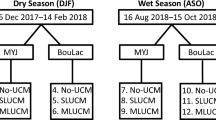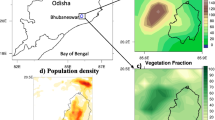Abstract
Mesoscale models with urban canopy models (UCM) have been increasingly used to study urban boundary layer processes. Using the data from a high-resolution Doppler lidar, automatic weather stations (AWS), and a flux tower located in the urban site, we assessed the performance of the urbanized Weather Research and Forecasting (WRF) model through three urban canopy models (the single-layer UCM, and the multi-layer BEP and BEM models) and four planetary boundary layer (PBL) schemes (the non-local first-order YSU, SH and ACM2 schemes, as well as the local TKE-based BouLac scheme) for one cloudy and one clear sky days. Results show that the WRF-Urban generally overestimates the sensible heat flux and underestimates the latent heat flux. The simulated 2-m temperature and 10-m wind speed are more sensitive to UCMs than to PBL schemes. Using the BouLac PBL scheme and the multi-layer BEP generates the best agreement with AWS observations. Simulations with the multi-layer BEM produce the highest mixing-layer heights. The convective boundary layer (CBL) from the single-layer UCM experiment develops at the slowest pace when compared with other two multi-layer UCMs. When the single-layer UCM is used, simulations with the non-local mixing YSU, SH and ACM2 schemes perform better than the TKE-based scheme (BouLac) for representing the CBL structure. Additionally, the scale-aware SH scheme considering the effect of grid resolution on the vertical dimension, simulates the potential temperature profiles that are closest to observations.











Similar content being viewed by others
References
Barlage M, Miao S, Chen F (2016) Impact of physics parameterizations on high-resolution weather prediction over two Chinese megacities. J Geophys Res Atmos 121(9):4487–4498
Bougeault P, Lacarrere P (1989) Parameterization of orography-induced turbulence in a mesobeta-scale model. Mon Weather Rev 117(8):1872–1890
Chen F, Dudhia J (2001a) Coupling an advanced land surface-hydrology model with the Penn State-NCAR MM5 modeling system. Part I: model implementation and sensitivity. Mon Weather Rev 129:569–585
Chen F, Dudhia J (2001b) Coupling an advanced land surface-hydrology model with the Penn State-NCAR MM5 modeling system. Part II: preliminary model validation. Mon Weather Rev 129:587–604
Chen F, Kusaka H, Bornstein R, Ching J, Grimmond CSB, Grossman-Clarke S, Loridan T, Manning KW, Martilli A, Miao S (2011) The integrated WRF/urban modelling system: development, evaluation, and applications to urban environmental problems. Int J Climatol 31(2):273–288
Ek MB, Mitchell KE, Lin Y, Rogers E, Grummann P, Koren V, Gayno G, Tarplay JD (2003) Implementation of the Noah land-use model advances in the NCEP operational mesoscale Eta model. J Geophys Res Atmos 633(108):D22 (GCP 12-1)
García-Díez M, Fernández J, Fita L, Yagüe C (2013) Seasonal dependence of WRF model biases and sensitivity to PBL schemes over Europe. Q J R Meteorol Soc 139(671):501–514
Hariprasad KBRR, Srinivas CV, Singh AB, Rao SVB, Baskaran R, Venkatraman B (2014) Numerical simulation and intercomparison of boundary layer structure with different PBL schemes in WRF using experimental observations at a tropical site. Atmos Res 145–146:27–44
Hong SY, Pan HL (1996) Nonlocal boundary layer vertical diffusion in a medium-range forecast model. Mon Weather Rev 124:2322–2339
Hong SY, Noh Y, Dudhia J (2006) A new vertical diffusion package with an explicit treatment of entrainment processes. Mon Weather Rev 134(9):2318–2341
Hu XM, Nielsen-Gammon JW, Zhang F (2010) Evaluation of three planetary boundary layer schemes in the WRF model. J Appl Meteorol Climatol 49(9):1831–1844
Huang M, Gao Z, Miao S, Chen F, LeMone MA, Li J, Hu F, Wang L (2017) Estimate of boundary-layer depth over Beijing, China, using Doppler lidar data during SURF-2015. Bound-Layer Meteorol 162(3):503–522
Iacono MJ, Delamere JS, Mlawer EJ, Shephard MW, Clough SA, Collins WD (2008) Radiative forcing by long-lived greenhouse gases: calculations with the AER radiative transfer models. J Geophys Res Atmos 113(D13):13103
Janjic ZI (1994) The step-mountain eta coordinate model: further developments of the convection, viscous sublayer, and turbulence closure schemes. Mon Weather Rev 122:927–945
Kain JS (2004) The Kain-Fritsch convective parameterization: an update. J Appl Meteorol 43(1):170–181
Kusaka H, Kondo H, Kikegawa Y, Kimura F (2001) A simple single-layer urban canopy model for atmospheric models: comparison with multi-layer and slab models. Bound-Layer Meteorol 101(3):329–358
Martilli A, Clappier A, Rotach MW (2002) An urban surface exchange parameterization for mesoscale models. Bound-Layer Meteorol 104(2):261–304
Masson V (2000) A physically-based scheme for the urban energy budget in atmospheric models. Bound-Layer Meteorol 94(3):357–397
Masson V, Grimmond CSB, Oke TR (2011) Evaluation of the Town Energy Balance (TEB) scheme with direct measurements from dry districts in two cities. J Appl Meteorol 41(3):1249–1264
Miao S, Chen F (2014) Enhanced modeling of latent heat flux from urban surfaces in the Noah/single-layer urban canopy coupled model. Sci China: Earth Sci 57(10):2408–2416
Miao S, Chen F, Lemone MA, Tewari M, Li Q, Wang Y (2009) An observational and modeling study of characteristics of urban heat island and boundary layer structures in Beijing. J Appl Meteorol Climatol 48(3):484–501
Miao S, Dou J, Chen F, Li J, Li A (2012) Analysis of observations on the urban surface energy balance in Beijing. Sci China: Earth Sci 55(11):1881–1890
Pleim JE (2007) A combined local and nonlocal closure model for the atmospheric boundary layer. Part I: model description and testing. J Appl Meteorol Climatol 46(9):1383–1395
Roth M (2000) Review of atmospheric turbulence over cities. Q J R Meteorol Soc 126(564):941–990
Salamanca F, Martilli A (2010) A new building energy model coupled with an urban canopy parameterization for urban climate simulations-part II: validation with one dimension off-line simulations. Theor Appl Climatol 99(3–4):345–356
Shin HH, Hong SY (2011) Intercomparison of planetary boundary-layer parametrizations in the WRF model for a single day from CASES-99. Bound-Layer Meteorol 139(2):261–281
Shin HH, Hong SY (2015) Representation of the subgrid-scale turbulent transport in convective boundary layers at gray-zone resolutions. Mon Weather Rev 143(1):250–271
Steeneveld GJ, Tolk LF, Moene AF, Hartogensis OK, Peters W, Holtslag AAM (2011) Confronting the WRF and RAMS mesoscale models with innovative observations in the Netherlands: evaluating the boundary layer heat budget. J Geophys Res: Atmos 116(D23):2053–2056
Sukoriansky S, Galperin B, Perov V (2005) Application of a new spectral model of stratified turbulence to the atmospheric boundary layer over sea ice. Bound-Layer Meteorol 117:231–257
Thompson G, Eidhammer T (2014) A study of aerosol impacts on clouds and precipitation development in a large winter cyclone. J Atmos Sci 71(10):3636–3658
Xie B, Fung JCH, Chan A, Lau A (2012) Evaluation of nonlocal and local planetary boundary layer schemes in the WRF model. J Geophys Res Atmos 117(D12):12103
Yang J, Wang ZH (2014) Physical parameterization and sensitivity of urban hydrological models: application to green roof systems. Build Environ 75(75):250–263
Zhang Y, Miao S, Dai Y, Liu Y (2013) Numerical simulation of characteristics of summer clear day boundary layer in Beijing and the impact of urban underlying surface on sea breeze. Chin J Geophys 56(8):2558–2573 (in Chinese)
Zhang Y, Miao S, Li Q, Dai Y (2017) Numerical simulation of the impact of urban underlying surface on fog in Beijing. Chin J Geophys 60(1):22–36 (in Chinese)
Zhong S, Qian Y, Zhao C, Leung R, Yang XQ (2015) A case study of urbanization impact on summer precipitation in the Greater Beijing metropolitan area: urban heat island versus aerosol effects. J Geophys Res Atmos 120(20):10903–10914
Acknowledgements
This work was supported by the National Key Projects of Ministry of Science and Technology of China (Grant nos. 2017YFA0604002, 2016YFC0203304, and 2015DFA20870); the National Natural Science Foundation of China (Grant no. 41275022); the Startup Foundation for Introducing Talent of NUIST (Grant no. 2017R088); the National Center for Atmospheric Research/Water System Program; and U.S. Department of Agriculture/National Institute of Food and Agriculture (Grant no. 20156700323460). We greatly appreciate two anonymous reviewers for their careful review and valuable comments which led to substantial improvement of this manuscript.
Author information
Authors and Affiliations
Corresponding author
Additional information
Responsible Editor: S.-W. Kim.
Rights and permissions
About this article
Cite this article
Huang, M., Gao, Z., Miao, S. et al. Sensitivity of urban boundary layer simulation to urban canopy models and PBL schemes in Beijing. Meteorol Atmos Phys 131, 1235–1248 (2019). https://doi.org/10.1007/s00703-018-0634-1
Received:
Accepted:
Published:
Issue Date:
DOI: https://doi.org/10.1007/s00703-018-0634-1




